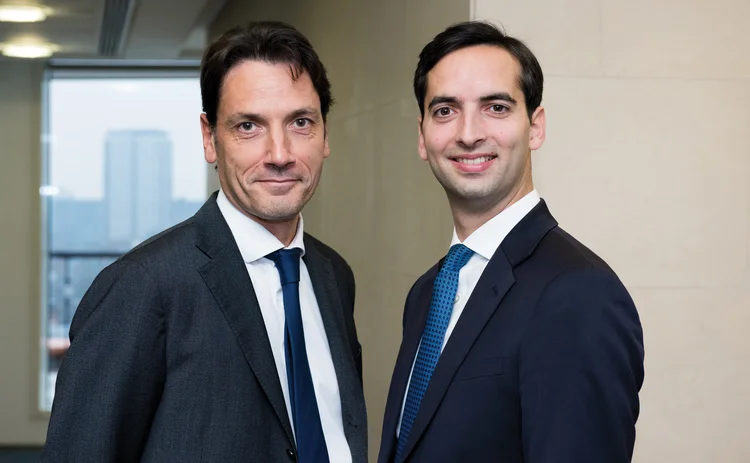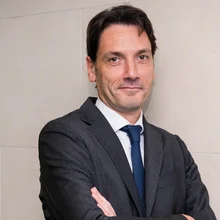
Credit derivatives house of the year: BNP Paribas
Risk Awards 2019: French bank now a top-tier player in US indexes, as it adds new clients – and new tech

To clients of BNP Paribas, it may appear the firm’s salesforce has developed an uncanny, almost eerie power to anticipate their trade intentions.
Marc de Belsunce, the bank’s head of European credit sales, says his team, while skilled, are not mind-readers. But they do have some help. “We developed some AI algorithms to add intelligence to the sales process,” says de Belsunce.
The algorithms, known collectively as Omega, pull in data and generate analysis of client activity in real time, serving as a virtual sales assistant.
BNP Paribas’s salespeople use Omega to manage the entire lifecycle of a trade, from initial client contact through to execution. “It’s a one-stop-shop for all sales activity,” says de Belsunce.
At its core, Omega is a central repository for all the bank’s client information – not only the trades they’ve done, but also quotes requested, enquiries made and research consumed. On top of this, the firm has built natural language processing (NLP) and predictive AI algorithms to pull valuable insights from this trove of data.
“When we receive an enquiry for a client, the AI algorithms within the Omega system will suggest trade ideas based on their past behavior,” says de Belsunce. “If a client wants to do something, the algorithm may generate some other ideas, and sales will be able to call the client and say, ‘Maybe we have something that is of interest’, which could be a relative value or cash bond trade idea. It is a way to increase the relevance of the sales pitch.”
The concept is similar to Amazon’s recommendation engine, which drives 35% of the online retailer’s sales, according to McKinsey.
At first, the sales teams were “a bit reluctant” to use the new technology, says de Belsunce. “They were asking, ‘are you sure [the AI recommendations] are going to be relevant for my client?’ But when they started using it, they were very surprised by the results. They told us it was really helpful.”
The AI algorithms also help the firm’s traders to move risk more efficiently. “When trading desks share their axes, the AI gives them a list and order of clients to whom it will be most relevant,” says de Belsunce.

This digitisation of sales is central to the bank’s wider effort to fully integrate its global markets business lines, which began four years ago. This year, the credit derivatives business was assimilated into global markets, alongside equity derivatives, fixed income, credit and foreign exchange. The move gave the credit derivatives business access to a wider client base, and a number of equities clients “have been integrated into our credit coverage, and are looking at our fast exotics and cash investment offerings”, says de Belsunce.
Technology has been critical to those cross-selling efforts. “It supports our integrated business model, because a salesperson can offer everything to a client, whether that’s credit derivatives or equities,” says de Belsunce.
The results have been impressive – especially in products, such as US credit default swap (CDS) indexes, where the firm has historically lagged competitors.
BNP Paribas has long been a force in European CDS index trading, ranking as the top dealer in iTraxx indexes on Bloomberg’s swap execution facility (Sef) since 2014. But five years ago, it ranked a lowly sixth for US CDS trading volumes.
The firm has steadily climbed the rankings since then, rising to fourth in 2017, and holding the second spot through the first three quarters of 2018.
“Where we improved a lot is in the US. We were ranked number six in 2014 and year-to-date, we are second,” says de Belsunce. “So there was really an improvement in the US.”
He says the firm has made similar gains in single-name CDS trading, although a lack of public data makes that hard to verify.
Clients attest to BNP Paribas’ improved execution capabilities.
“They have been our top counterparty on indexes, index options, index tranches and bespoke tranches,” says a credit trader at a hedge fund in London.
Another client says the firm’s bid-offer spreads for off-the-run indexes traded on Sefs have tightened significantly in the past year, while decline rates have dropped to nil, even for large trades.
And while the Sef rankings for CDS indexes are the most visible sign of BNP Paribas’ growing market share in credit derivatives trading, the firm has also made gains in less liquid flow products, such as CDS tranches and total return swaps (TRS) on the iBoxx bond indexes. “Those are products where we’ve tried to make a push to increase market share and volume,” says Paul-Louis Laferrere, credit structurer at BNP Paribas.
BNP Paribas’s structured credit business has also benefited from the closer integration with global markets. The move “enabled the franchise to grow and get inspiration from the other parts of global markets, and replicate those successes”, says Laferrere.
In some big client segments, such as asset management, around 25% of all volumes have been with customers that are new to the bank’s credit business – but might have been existing global markets clients.

The equity derivatives business, which was assimilated earlier, was a particular source of inspiration. “We looked at those equity strategies that were successful and tried to implement those that made sense in the credit markets,” says Laferrere. That led to the launch of a series of smart beta strategies, which aim to profit from structural inefficiencies and market trends using alternative indexes. For instance, the firm has built a series of smart beta products that exploit the relationship between high-yield and investment-grade names, or financial and non-financials, which have proven popular with traditional equity clients.
The integration has also given birth to a line of hybrid products that offer rates or equities payoffs with credit underlyings, which are marketed to the entire global markets client base. The credit team was able to capitalise on the growth of the market for options on CDSs to create a suite of autocallable credit-linked notes (CLNs). Examples include CLNs with an autocall condition linked to equity or credit indexes. These have proven popular with more sophisticated equity and rates investors that wanted to add credit risk to their portfolios – for some clients, such products now make up around 15% of their total business.
The firm was also able to package-up relative-value opportunities in the market – whether across bonds in different currencies, bonds and single-name CDSs, or CDS indexes and their constituents – in a series of innovative structures, making them more accessible to investors. Arguably the most lucrative of these was the difference in European corporate bond yields and single-name CDS spreads, a side-effect of the European Central Bank’s (ECB) corporate sector purchase programme.
“The ECB’s corporate bond purchases brought those yields down massively, and the CDS spreads did not collapse by as much,” says Laferrere. The gap widened to more than 30 basis points at the start of the year, and has declined steadily since then. Over that period, the bank has traded 30 clips of these positive-basis packages.
“The basis itself was supported by macro factors, which meant a lot of investors that might not have invested in basis packages before were looking into it,” says Laferrere. “Our execution capabilities allowed us to source the basis at an attractive level, and our structuring expertise allowed us to offer it in formats that were investable to a wider client base.”
To increase participation, BNP Paribas worked with clients on funded-to-maturity transactions, with locked-in financing. The bank leaned on its position as a top repo counterparty to money market funds to borrow targeted bonds and finance client positions. The resulting structures transfer most of the positive basis pick-up to investors without attracting undesired mark-to-market volatility from an accounting standpoint. These funded-to-maturity basis packages proved popular with large institutional investors as far-flung as South America and Africa.
BNP Paribas’s strength across flow and structured credit derivatives makes it something of a rarity. Even as the ranks of full-service credit derivatives houses has thinned, and some banks have exited the market completely, the integration of credit derivatives within BNP Paribas’s global markets operation has given the business added momentum.
“One of our strengths today is the fact that we have a complete offer, from flow derivatives – across single-name CDSs, indexes, options and tranches – to the most complex structured credit derivatives,” says de Belsunce. “We always had a clear commitment to having a broad offering. This year, we were much more efficient in delivering that message to clients, and printing trades with different client types across the globe.”
Only users who have a paid subscription or are part of a corporate subscription are able to print or copy content.
To access these options, along with all other subscription benefits, please contact info@risk.net or view our subscription options here: http://subscriptions.risk.net/subscribe
You are currently unable to print this content. Please contact info@risk.net to find out more.
You are currently unable to copy this content. Please contact info@risk.net to find out more.
Copyright Infopro Digital Limited. All rights reserved.
As outlined in our terms and conditions, https://www.infopro-digital.com/terms-and-conditions/subscriptions/ (point 2.4), printing is limited to a single copy.
If you would like to purchase additional rights please email info@risk.net
Copyright Infopro Digital Limited. All rights reserved.
You may share this content using our article tools. As outlined in our terms and conditions, https://www.infopro-digital.com/terms-and-conditions/subscriptions/ (clause 2.4), an Authorised User may only make one copy of the materials for their own personal use. You must also comply with the restrictions in clause 2.5.
If you would like to purchase additional rights please email info@risk.net
More on Awards
Clearing house of the year: LCH
Risk Awards 2025: LCH outshines rivals in its commitment to innovation and co-operation with clearing members
Best use of machine learning/AI: CompatibL
CompatibL won Best use of machine learning/AI at the 2025 Risk Markets Technology Awards thanks to its ground-breaking use of LLMs for automated trade entry, redefining speed and reliability in what-if analytics
Markets Technology Awards 2025 winners’ review
Vendors jockeying for position in this year’s MTAs, as banks and regulators take aim at counterparty blind spots
Equity derivatives house of the year: Bank of America
Risk Awards 2025: Bank gains plaudits – and profits – with enhanced product range, including new variants of short-vol structures and equity dispersion
Law firm of the year: Linklaters
Risk Awards 2025: Law firm’s work helped buttress markets for credit derivatives, clearing and digital assets
Derivatives house of the year: UBS
Risk Awards 2025: Mega-merger expected to add $1 billion to markets revenues, via 30 integration projects
Interest rate derivatives house of the year: JP Morgan
Risk Awards 2025: Steepener hedges and Spire novations helped clients navigate shifting rates regime
Currency derivatives house of the year: UBS
Risk Awards 2025: Access to wealth management client base helped Swiss bank to recycle volatility and provide accurate pricing for a range of FX structures







